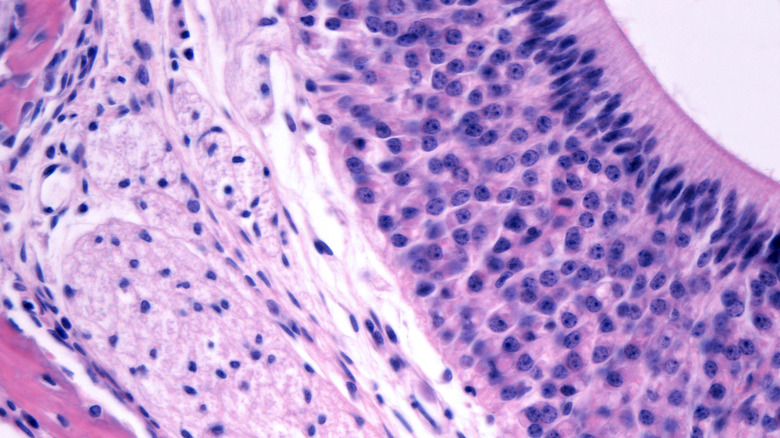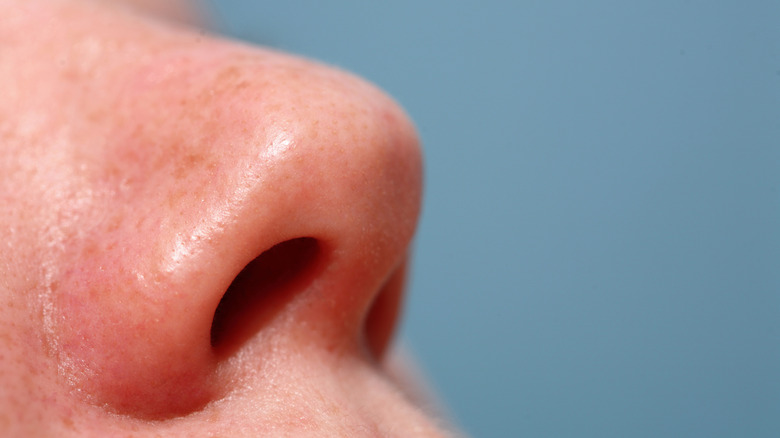The 'Useless' Organ Only Some Humans Have
We humans have several vestigial parts of our anatomy; male nipples, for example, or the "useless" organ that's more important to our health than we realize. Vestigial structures are also the reason some people can wiggle their ears and some can't. In the latter case, we can see how "vestigial" doesn't necessarily mean something is completely useless. In fact, most biologists consider vestigial structures as still serving some purpose even if they no longer serve their primary function. But things get complicated when it comes to the vomeronasal organ — a surprisingly controversial pheromone-detecting organ which sits in the roof of some people's nasal cavities (though its exact position remains a point of debate).
This small piece of our nasal anatomy is what's known as an accessory olfactory sense organ which means it is not a crucial part of our ability to detect smell but it has a role in olfaction. At least, it used to. Or maybe it still does. The thing is, there is an ongoing debate around the vomeronasal organ which is surprisingly contentious and extends from the prevalence of this mysterious aspect of our physiognomy to its usage.
The organ is known to appear inside the noses of most amphibians, reptiles, and mammals, where it is used to identify chemical compounds such as pheromones. This organ is much larger in animals than it is in humans, to the extent that we're not even really sure how many of us have one. In fact, it's often overlooked by ear, nose, and throat experts during examinations. But that's not the only thing about the organ that remains in question.
The vomeronasal organ is a vestigial structure in some humans
In the human nose, the vomeronasal organ, or VNO, is a very small structure located in an area known as the anteroinferior (in front of and below) portion of the nasal septum. A vascular and glandular network sits behind the organ, which otherwise consists of a sac and a duct opening. The organ houses special sensory cells which can detect pheromones and produce what's called gonadotropin-releasing hormones — a hormone made in the hypothalamus which in men plays a role in testosterone production and in women plays a role in the ovaries making estrogen and progesterone.
Just like everything else with the vomeronasal organ, its discovery and history are somewhat unclear. It is thought that Dutch botanist and anatomist Frederik Ruysch first described the organ back in 1703 but this isn't entirely obvious as there exist no precise descriptions from the man himself. Danish surgeon Ludwig Jacobson, however, described the VNO in mammals in 1803 but notably denied that human beings possessed the organ — which has since become known as by its other name, Jacobson's organ.
Despite Jacobson's denial of its existence in humans, the organ has been detected multiple times over the years, using a variety of methods from direct observation and endoscopic exploration, to CT scans, MRIs, and electron microscopy. Yet to this day both its presence and prevalence in human beings is debated.
How many of us have the vomeronasal organ?
The vomeronasal organ is a part of our anatomy, but even the prevalence of this vestigial organ is debated as studies have shown it to be present in humans to varying degrees. A 1998 study published in Acta Oto-Laryngologica, for example, looked at the nasal septae of 200 adult patients and used different methods to identify the organ, finding that it appeared with varying frequencies depending on those methods. Anterior rhinoscopy, for example, revealed physical elements that appeared to represent the vomeronasal organ in 16% of participants, but that rose to 76% when the research team used nasal endoscopes.
Another study from 1985, published in The Journal of Otolaryngology, looked at 100 adults and found the opening of the vomeronasal organ in 39% of them. However, post mortem examinations revealed that 70% of specimens had vomeronasal structures. Other reports seem to suggest children are more likely to have the organ while some studies show that it's present in two-thirds of young people.
Whatever the actual prevalence of the vomeronasal organ, then, it's clearly a part of the human anatomy for some people, and its presence in humans is well-established. But its function and importance remains unclear.
What is the function of the vomeronasal organ in humans?
Studies have been carried out to try to demonstrate that the vomeronasal organ has a function for humans. A 2018 review in the journal Cureus noted that studies have used what's called an "evoked electrical potential" in the nasal mucosa and have claimed to have shown a receptor function in the organ. However, there is also evidence that negates these claims, showing genes involved in the receptor function process are nonfunctional in humans.
This relates to the equally controversial topic of pheromones in humans. In animals, communication via pheromones is an important part of reproduction. As far as humans are concerned, there are several studies which support the claim that we can produce pheromones — essentially chemical messengers — and that we also have pheromone receptors. It's also thought that the VNO played a role in detecting these pheromones but this is where the vestigial aspect of the organ comes in as more recent studies suggest this whole system is nonfunctional in humans.
One 2011 study published in the journal European Annals of Otorhinolaryngology, Head and Neck Diseases explains how the VNO develops in human embryos, complete with nerve fibers that connect it to the hypothalamus. But after this initial development, the organ regresses and those neural connections are lost. All of which suggests that at one time we may have been communicating via pheromones but that today we've lost that ability — at least via the VNO.



